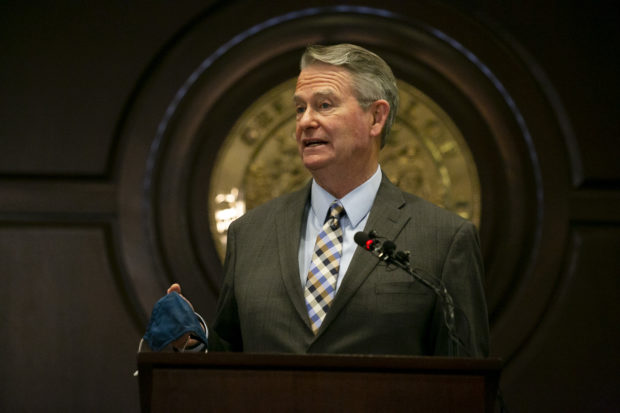Soon after Idaho Gov. Brad Little declared an emergency due to COVID-19, epidemiologist Dr. Sky Blue and other medical experts were planning the next steps.
It was March 2020 and little was known about the incredibly infectious pathogen first spotted in Wuhan, China. But as neighboring Washington state became home to the U.S.’s first hotspot, it became clear that Idaho was in the virus’s wrecking path.
One of the first questions state experts and leaders asked was what to do with schools, Blue recalled.
Then on March 23, the State Board of Education ordered a statewide school closure, after Little sidestepped the decision.
“We don’t have all the answers,” then-State Board President Debbie Critchfield, and today a Republican candidate for State Superintendent of Public Instruction, said at the time. “And in many cases, we don’t have all the questions yet.”
The uncertainty in the early weeks of the pandemic stayed with education decisionmakers throughout. Idaho schools vacillated through a volley of coronavirus mitigation efforts. School board members wrestled with a rapidly changing coronavirus landscape fueled by new dangerous variants.
Idaho’s path of local virus control efforts was marked by continual clashes over mask mandates, relatively lax restrictions in local schools and a flurry of temporary needs-based school closures. All told, more than 4,800 Idahoans died from COVID-19 and around 440,000 infections were recorded, state numbers show. About 926,000 Idahoans have been fully vaccinated.
Two variants posed threats to the operations of health care systems, business and more. The delta variant, in summer 2020, sent cases skyrocketing for months, landing Idaho hospitals in a formal crisis declaration for the first time in September 2020. Soon after the state escaped that crisis, hospitals entered a new one as the fast-spreading but less severe omicron variant took hold, along with blood and staff shortages.
“The sheer impact of (omicron) was not mild in the health care system, but we did see it start to uncouple transmission from hospitalization and death,” Blue said.
The omicron-fueled surge saw a wave of schools close this year, as they faced high absence rates in bus drivers, teachers and lunch workers. Out of 184 districts and charters, though, only a small percentage had any type of closure for a short period of time, according to Idaho Education News’ tracking.
The vaccines, meanwhile, were proven to significantly reduce rates of hospitalization and death from COVID-19. Dr. Kenneth Krell, former intensive care unit director at Eastern Idaho Regional Medical Center, can’t imagine how many more infections, hospitalizations and deaths there would have been without the development of vaccines.
“It really is a remarkable story of the vaccines,” Krell said.
Vaccine uptake has stalled out in Idaho, where 60% of people age 5 and up are vaccinated compared to 81% nationally. In the week starting Feb. 27, only 6,000 Idahoans got vaccinated.

Local control
In June 2020, Little shifted most pandemic control responsibilities to local leaders after leading a top-down state approach for months. The decision kicked off tense discussions over mask mandates and social restrictions to hundreds of local school boards, city councils and health district boards.
In West Ada School District, hundreds of parents showed up to board meetings with yellow shirts and occasional signs protesting mask mandates. The school board trustee leading that meeting later resigned. At Central District Health, a board meeting cancelled over protestors. A board member left early, as protestors banged on buckets and played sounds from the movie “Scarface” outside her home where her two children were home alone.
Amid the clashes over masks and restrictions, determining the pandemic’s true toll on Idaho K-12 education is difficult. But early indicators aren’t promising.
Idaho’s four-year graduation rate fell by 2 percentage points in 2021, dropping to a four-year low of 80.1%. In 2020, grad rates rose — after state leaders halted some graduation requirements amid the pandemic’s early days.
State Superintendent of Public Instruction Sherri Ybarra pegged COVID-19 as a cause for last year’s backslide.
Test scores, meanwhile, showed other declines. Reading proficiency in third graders dropped by more than 3 percentage points from 2019 to 2021, from 73.7% to 70.1%. Scores were already falling from the 2018 benchmark of 74.6%. Students were not tested in 2020 due to the pandemic.

Board decisions
If school boards had pulled in medical experts sooner, former St. Luke’s Health System CEO Dr. David Pate thinks schools could have operated in-person for longer, and there may have not been any blips. He said experts could have guided local trustees on what actions are critical to safe school operations, avoiding the rush to sanitize surfaces that some schools still follow despite widespread medical evidence that the virus spreads primarily through airborne respiratory droplets.
In the race to end mask mandates, Pate said a school board has never asked him what other preventive measures to keep in place instead of mask requirements. He said he sympathizes with board members getting flak from parents over mask requirements, but he stresses that COVID-19 mitigation efforts aren’t zero-sum, just like other health care decisions.
“Masks would be the best solution, but if you’re going to say no to masks … have a discussion about what we’re trying to do instead of masks,” Pate said.
Calming infection rates lately have prompted local, state and federal officials to ease up on safety messaging and safety measures.
Similar assurances also came in early 2021, before delta and omicron brought Idaho hospitals to their breaking point twice, prompting the Gem State’s first use of its hospital disaster plan that allows facilities to ration health care.
More reading: We’re reflecting on COVID-19 and its impacts two years into the pandemic. View our updated timeline of events here, and hear what a parent, a former school board member and student here.
